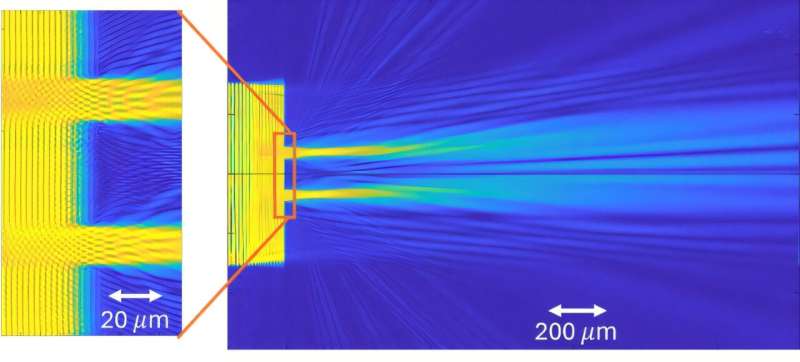A world-famous light experiment from 1801 has now been carried out with sound for the first time. Research by physicists in Leiden has produced new insights that could be applied in 5G devices and the emerging field of quantum acoustics. The study is published in the journal Optics Letters.
Ph.D. student Thomas Steenbergen says, “We saw that sound waves in materials behave in the same way as light, but also slightly differently. With a mathematical model, we can now explain and predict this behavior.”
Thomas Young’s famous double-slit experiment
Young’s famous double-slit experiment was the first to show that light sometimes behaves like a particle and sometimes like a wave. In the experiment, light was shone through two narrow slits. Behind the slits, the light waves either reinforced or canceled each other out due to interference, creating a pattern of bright and dark stripes—an interference pattern.
The same experiment was later done with particles, showing that all particles can behave both as a particle and as a wave. Over time, the double-slit experiment has been carried out with all sorts of quantum objects—from electrons and neutrons to buckyballs, molecules made of 60 carbon atoms.
Now with sound instead of light
Steenbergen and colleague Löffler wanted to understand exactly how sound behaves on the smallest scale. The double-slit experiment provides valuable insight here. With his experiment setup, Steenbergen built on a research project started by physics bachelor student Krystian Czerniak.
In the experiment, the researchers used gigahertz sound waves, vibrating a billion times per second—far above what humans can hear.

The experiment
The sound waves were directed at a small piece of material: the semiconductor gallium arsenide, often used in electronic devices. Colleague Matthijs Rog from Kaveh Lahabi’s research group carved two tiny grooves (slits) in this material using an ion beam.
Steenbergen explains, “We then measure the sound with an extremely precise optical scanner. This device can measure sound literally everywhere, including in and in front of the slits. We can measure the height of the sound waves with picometer precision—that’s one millionth of a micrometer.”
Similarities—and differences
Just like in the double-slit experiments with light, an interference pattern appears at the back: you can clearly see where the sound is reinforced and where it cancels out.
Steenbergen adds, “But if you look closely, you also see that the pattern is not completely symmetrical. Sound waves don’t move the same way in all directions. The speed of the waves depends on the angle at which they pass through the material.” By developing a mathematical model, the team was able to explain these differences and predict them accurately.
An old experiment opens new doors
Gigahertz sound waves are widely used in telecommunications, especially in 5G devices such as mobile phones. This research provides new knowledge that could be applied in these technologies, as well as in other micro-electronic devices and sensors that use sound.
It also provides insights for the emerging field of quantum acoustics, where sound waves on the tiniest (quantum) scale are used to carry information. In this way, an experiment from centuries ago is opening new doors once again.
More information:
Thomas Steenbergen et al, Young’s double-slit experiment with anisotropic GHz surface acoustic waves on gallium arsenide, Optics Letters (2025). DOI: 10.1364/ol.573360
Citation:
How sound and light act alike—and not—at the smallest scale (2025, November 13)
retrieved 14 November 2025
from
This document is subject to copyright. Apart from any fair dealing for the purpose of private study or research, no
part may be reproduced without the written permission. The content is provided for information purposes only.

